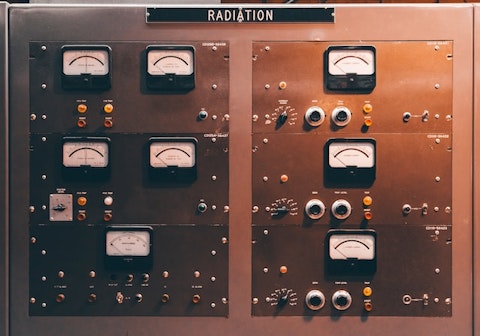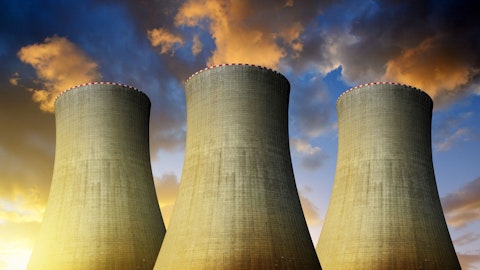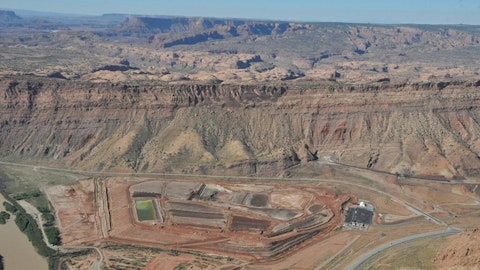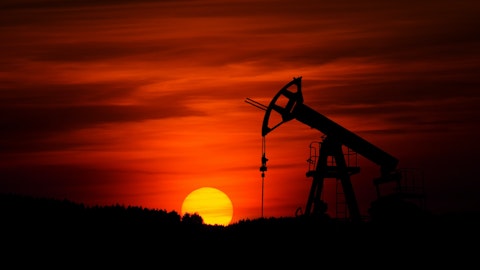Cameco Corporation (NYSE:CCJ) Q4 2022 Earnings Call Transcript February 9, 2023
Operator: Thank you for standing by. This is the conference operator. Welcome to the Cameco Corporation Fourth Quarter 2022 Conference Call. As a reminder, all participants are in listen-only mode, and the conference is being recorded. After the presentation, there will be an opportunity to ask questions. I would now like to turn the conference over to Rachelle Girard, VP of Investor Relations, Treasury and Tax. Please go ahead.
Rachelle Girard: Thank you, operator, and good morning, everyone. Welcome to Cameco’s fourth quarter conference call. I would like to acknowledge that we are speaking from our corporate office, which is on Treaty 6 territory, the traditional territory of Cree Peoples and the homeland of the Métis. With us today on the call are Tim Gitzel, President and CEO; Grant Isaac, Executive Vice President and CFO; Brian Reilly, Senior Vice President and Chief Operating Officer; Alice Wong, Senior Vice President and Chief Corporate Officer; and Sean Quinn, Senior Vice President, Chief Legal Officer and Corporate Secretary. I’m going to hand it over to Tim in just a moment to discuss how the improving growth outlook for nuclear power is translating into an improving growth outlook for Cameco.
After, we will open it up for your questions. As always, our goal is to be open and transparent with our communications. Therefore, if you have detailed questions about our quarterly financial results or should your questions not be addressed on this call, we will be happy to follow up with you after the call. There are a few ways to contact us. You can reach out to the contacts provided in our news release. You can submit a question through the contact tab on our website or you can use the Ask a question form at the bottom of the webcast screen, and we will be happy to follow up after this call. If you join the conference call through our website event page, there are slides available, which will be displayed during the call. In addition, for your reference, our quarterly investor handout is available for download in a PDF file on our website at cameco.com.
Today’s conference call is open to all members of the investment community, including the media. During the Q&A session, please limit yourself to two questions and then return to the queue. Please note that this conference call will include forward-looking information, which is based on a number of assumptions, and actual results could differ materially. You should not place undue reliance on forward-looking statements. Actual results may differ materially from these forward-looking statements, and we do not undertake any obligation to update any forward-looking statements we may make today, except as required by law. Please refer to our most recent annual information form and MD&A for more information about the factors that could cause these different results and the assumptions we have made.
With that, I will turn it over to Tim.
Tim Gitzel: Well, thank you, Rachelle, and welcome to everyone on the call today. We appreciate you taking the time to join us. I may be a bit late, but I want to wish all of you a Happy New Year, and I hope that you and your families are doing well. Over the holiday break, I spent some time reflecting on the past year at Cameco and of course, looking forward to the possibilities that lie ahead for 2023 and beyond. In terms of 2022, the one word that kept coming to mind was transformative. And as I think about 2023 and beyond the word that comes to mind is opportunity. In all my time leading Cameco and all my time in the industry, I’m not sure there has ever been a time when there has been more to be excited about. Starting at the company level.
From returning to stable operations at Cigar Lake and in Port Hope after 2 long years of stops and starts due to the COVID-19 pandemic. Continuing with the acquisition of a greater share of Cigar Lake to the restart of production at McArthur River, Key Lake and the pending acquisition of a 49% interest in Westinghouse, 2022 was a busy and transformative year for Cameco. Also, let’s not forget the 80 million pounds of long-term uranium contracts and the 17,000 tons of conversion services contracts added to the portfolio, making it one of the biggest contracting years we’ve ever had with a record number of contracts. This contracting success is expected to allow us to sustainably operate our assets and generate full cycle value for Cameco and therefore, provide our customers with access to the fuel they need to operate their reactors safely, cleanly, reliably and securely.
And in 2023 and beyond, we expect these transformative changes will create new opportunities for Cameco and build an even stronger foundation for growth as we continue our transition back to a Tier 1 run rate. The announcement we just made about a major supply agreement with Energoatom is a great example of one of those growth opportunities. We’ve reached an agreement on key commercial contract terms that once finalized, could see Cameco provide sufficient volumes of uranium and conversion to meet all of Ukraine’s nuclear fuel needs through 2035. We are incredibly proud of the pivotal role that we at Cameco will be able to play in helping Ukraine gain its energy independence. With the potential to supply about 67 million pounds 12 years, this contract could be the single largest supply contract in Cameco’s history.
I want to thank my friend, Energoatom, President, Petro Kotin and his team for their friendship and courage and for the trust they placed in Cameco. We are proud to be your partner. The supply agreement with Ukraine is a good reminder of why we believe that Cameco remains the best way to invest in the recovery in the uranium market. I’ll come back to 2023 and our plans for the year and beyond in more detail later, but first, I want to take a look back from an industry perspective. At the industry level, 2022 started with a couple of stark reminders of the deepening the geopolitical and origin risk in our industry. In January, Kazakhstan experienced the most significant instability since it became independent, raising concerns about the security of more than 40% of global uranium supply.
But sadly and undeniably, the most transformative events for both our industry and the world in 2022 from a supply and demand perspective was the Russian invasion of Ukraine at the end of February. It is set in motion what I believe is a geopolitical realignment, a realignment that is already transforming the way countries are planning for their future energy needs and that highlights the crucial role for nuclear power. More than ever, the world is looking for an energy solution that can solve three very significant challenges, the need to provide clean energy, the need to provide secure energy and the need to provide affordable energy. And if you still need convincing that there is no solution for tackling the global climate crisis and the energy crisis without nuclear energy, you might have dialed in to the wrong call.
As you all know, nuclear energy provides safe, reliable, affordable carbon-free baseload electricity while also offering energy security and independence. As a result, in 2022, we saw what I believe are transformative tailwinds for our industry developing. And thanks to the strategic and deliberate decisions Cameco has made over the past decade and our conservative financial management, we believe the company is extraordinarily well positioned, well positioned for these tailwinds driven by the focus on clean energy, by an energy crisis and by the geopolitical realignment that is occurring. We also believe we are well protected from the current macroeconomic headwinds. We have a strong balance sheet, a growing durable contract portfolio and our customers’ nuclear power plants are part of the critical infrastructure needed to guarantee the availability of 24 hour electricity to maintain essential services.
But as always, we will take a balanced and disciplined approach. So as we begin 2023, we’re excited about the opportunities for growth ahead of us with demand for safe, reliable, secure, affordable and carbon-free baseload electricity coming from across the globe. Today, there are 57 reactors under construction with nine units that could reach the start of commercial operation this year. I’m not going to tour you through country by country as I suspect you’ve already taken that tour, and that’s why you’re on the call today. Almost every day, there’s an announcement supporting the prevention of early reactor retirements, life extensions of the current reactor fleet, the expansion of existing reactor programs or new reactor programs. We have highlighted many of these developments in our MD&A.
Also around the world, we’re seeing momentum building for small modular reactors and advanced reactors and for non-traditional commercial uses of nuclear power, uses such as hydrogen and ammonia production, district heating and nuclear powered shipping. There are numerous companies and countries pursuing projects in these areas. As a result, there is demand growth occurring for nuclear fuel supplies and services in the near, medium and long term. So it’s easy to conclude that the demand outlook is durable and very bright. To meet this growing demand, we know that more supply will be needed, and therein lies the challenge. Low prices have led to growing supply concentration by origin and a growing primary supply gap. Along the way, these secondary supplies that have played such a crucial role in our industry have been drawn out of the market.
And taking the challenge of filling that gap to a whole new level is a desire by utilities to reduce their reliance on Russian nuclear fuel supplies in the future. Currently, the global nuclear industry relies on Russia for the supply of approximately 14% of uranium concentrates, 27% of conversion and 39% of enrichment. Utilities are now considering and planning for a variety of potential scenarios ranging from an abrupt and to Russian supply to a gradual phase out. It’s still early days and while supply uncertainty is not yet driving contracting at a replacement rate, we are getting closer. We’re seeing utilities beginning to pivot toward procurement strategies that more carefully weigh the risk to supply, including the origin risk. As a result, the industry saw about 113 million pounds in long-term contracting in 2022.

Photo by Dan Meyers on Unsplash
And we believe there is significant opportunity for Cameco to grow as we help our customers derisk their fuel supply needs. But what is really exciting for us is that we do not have to build new capacity to capture that growth. Our growth is expected to come from brownfield leverage, our existing suite of Tier 1 operating assets. We just need to turn up the assets we already have, a position we have not enjoyed in previous price cycles. We’re also excited about our strategic partnership with Brookfield Renewable to jointly acquire Westinghouse Electric Company. Our excitement stems from being able to extend the base of our reach in the nuclear fuel cycle at a time when there’s tremendous growth on the horizon for our industry. We are extending our reach with an investment in assets like ours that are strategic, that are proven, that are licensed and permitted and that are located in geopolitically attractive jurisdictions.
Assets that we expect will be able to participate in the growing demand profile for nuclear energy from their existing footprint. And assets that we expect will augment the core of our business, expand our ability to compete for more business and offer more solutions to our customers across the nuclear fuel cycle. So with the continued improvements in the market and our growing long-term contract portfolio, it’s time to revisit the production plans we laid out at the start of 2022. With approximately 180 million pounds of uranium and over 55,000 tons of conversion in long-term commitments, our customers are sending us clear signals that they recognize the significant challenges the supply side of our industry faces and that they see the value in securing access to Cameco’s strategic proven Tier 1 assets that are in geopolitically attractive jurisdictions.
The volume is almost 250 million pounds and over 80,000 tons of conversion if you include all potential Energoatom requirements. Therefore, we have decided to no longer make sense to target 15 million pounds of production on a 100% basis at McArthur River, Key Lake in 2024, but the plan for 18 million pounds of production. Also, we’ve decided not to pull back production to 13.5 million pounds on a 100% basis at Cigar Lake in 2024. We plan to continue to operate Cigar Lake at 18 million pounds per year. As a result, in 2023, we’re planning for our share of production from McArthur River, Key Lake and Cigar Lake to be 20.3 million pounds with a target to increase that to 22.4 million pounds in 2024. But that’s not the extent of our Tier 1 supply growth.
We also maintain the ability to expand and extend production from our existing Tier 1 assets. With planned production of 18 million pounds per year and annual license capacity of 25 million pounds at McArthur River, Key Lake, there’s an opportunity for further Tier 1 production growth. And we know there is additional uranium at Cigar Lake, but there is some work to do to determine the economics required to extend the mine life beyond its current reserve base. As well until the end of 2023, Inkai is expected to operate at 20% below its annual licensed production rate. However, its license allows for production at 20% above that rate or 12.5 million pounds a year, which would bring our share of its production to about 5 million pounds per year.
So if we took advantage of all these opportunities, our annual share of Tier 1 uranium supply could be about 32 million pounds. And we have our Tier 2 assets, which we plan to keep on care and maintenance, unless we can secure long-term contracts that provide returns similar to what we can currently achieve on our Tier 1 assets. In addition to our plans to expand uranium production, we’re also working on expanding production at our Port Hope UF6 conversion facility. To satisfy our growing book of long-term business at a time when conversion prices are at historic highs, we’re targeting annual production of 12,000 tonnes by 2024. The improving market fundamentals, our growing contract portfolio for both uranium and fuel services and our plans for increased production set us on a path that provides line of sight to a significant improvement in our financial performance.
Key to our ability to continue to align our production decisions with our portfolio of contract commitments and opportunities are the investments we have and will continue to make in digital and automation technologies. We expect these investments will allow us to operate our assets more safely, more efficiently and with more flexibility. We also expect they will help support the 30% reduction in greenhouse gas emissions we are targeting for 2030 compared to a 2015 baseline. With our experience operating in this industry, we understand that to create long-term value and provide supplier reliability for our customers, we must build a home for our production under a long-term contract before we pull it out of the ground. So we will continue to make strategic supply decisions in all segments of our business and in accordance with our customers’ requirements.
As an independent commercial supplier, we can provide our customers with access to proven and reliable productive capacity. With substantial Canadian productive capacity, our supply meets increasingly stringent ESG requirements. It can provide diversity from state-owned enterprises and help to alleviate utilities future supply from origin and trade policy risk. As you know, the financial aspect of our strategy is to ensure we have a solid balance sheet and the ability to self-manage risk. At the end of the year, including the proceeds from an equity issue to support our planned acquisition of a 49% share of Westinghouse, we had $2.3 billion in cash, $1 billion in long-term debt and $1 billion in an undrawn credit facility. And we expect to begin to see a significant improvement in our cash flow, thanks to the planned ramp-up in production at McArthur River, Key Lake and at the Port Hope UF6 conversion facility.
As well, the higher prices that are being discovered in our currently improving market are expected to flow through our existing contract portfolio and further contribute to an improving financial performance. And with an inventory of unencumbered Tier 1 and Tier 2 pounds in the ground, rising prices will also create the opportunity to negotiate new long-term commitments with appropriate pricing mechanisms, commitments that will underpin the long-term operation of our productive capacity. So we’re optimistic about the growth in demand for nuclear power, both traditional and non-traditional. We’re optimistic about the growth in demand for nuclear fuel products and services, and we’re optimistic about the opportunity for Cameco and capturing long-term value across the nuclear fuel value chain and supporting the transition to a net zero carbon economy.
We will continue to do what we said we would do. Let me just remind you what we said we would do. We’re aligning our production decisions with our contract portfolio and the market fundamentals. We’re being strategically patient in our marketing activities, and we are conservatively managing our balance sheet to ensure that we can execute on our strategy and self-manage risk. This strategy has positioned us well to take advantage of the fundamentals I spoke of earlier. We have operating Tier 1 assets that are licensed, permanent, long-lived and our proven operations that have expansion capacity. We have fully permanent and proven Tier 2 assets that don’t make sense at today’s prices, but when you think about them in the context of a looming supply gap, there’s a potential pathway for them to add value for us in the future, but we’ll continue to be very disciplined in our evaluation on that front.
Thanks to our disciplined contracting strategy, we have had a contract portfolio that has protected us well during the worst down cycle in our business. And as the uranium market improves further, we will continue to secure homes for our in-ground inventory that has not yet been committed. And we’re more than just mining. Something we don’t talk about much or even, in fact, to get much credit for is our advanced uranium projects and our exploration portfolio. We believe our portfolio of resources rivals any particularly when you consider the proximity of those resources to existing infrastructure. We expect these resources will add value well beyond the current price cycle. Then we have our investments across the nuclear fuel cycle in refining, in conversion and in CANDU fuel fabrication for heavy water reactors, where we are focused on continuing to lock in significant value for this segment of our business.
Additionally, we are positioning Cameco to respond to the growing need for uranium fuel to generate safe, clean, reliable and affordable electricity by exploring new opportunities that we expect will further our participation in the nuclear fuel value chain. New opportunities like the pending acquisition of a share of Westinghouse. We expect the acquisition will augment our current suite of assets and allow us to better meet our customers’ nuclear fuel cycle needs for light water reactors in areas where we have not previously participated. Through our fuel manufacturing capabilities and investment in global laser enrichment, we’re exploring fuel fabrication of new fuels, including high assay, low-enriched uranium or HALEU. We’re also planning to participate in the responsible cleanup of leftover byproducts from a previous generation of enrichment facilities no longer in operation.
GLE has an agreement with the U.S. Department of Energy that would allow it to repurpose legacy waste by re-enriching depleted uranium tails into commercial source of uranium and conversion products to fuel nuclear reactors. And we are involved in developing the capability to produce commercial low-enriched uranium fuel using lasers for the world’s existing and future fleet of light water reactors with what we believe will be greater efficiency and flexibility than current enrichment technologies. These opportunities align with our commitment to manage our business responsibly and sustainably and to increase our contribution to global climate change solutions. Our decisions are deliberate. We are a responsible, commercially motivated supplier with a diversified portfolio of assets, including a Tier 1 production portfolio that is among the best in the world.
We’re committed to operating sustainably by protecting, engaging and supporting the development of our people and their communities and to protecting the environment, something we’ve been doing for over 30 years. We have determined that our strategy of operational flexibility, supply discipline and financial discipline will allow us to achieve our vision of energizing a Clean Air world. And it is a strategy that we expect will deliver long-term value in a market where demand for safe, secure, reliable and affordable clean nuclear energy is growing. Before I conclude, I just want to recognize some changes to the executive team here at Cameco. Grant Isaac has been appointed Executive Vice President and remains our Chief Financial Officer. Joining the executive team from finance is Heidi Shockey, who will be our Senior Vice President and Deputy Chief Financial Officer.
So I just want to congratulate both of them. And with that, we’re happy to answer any questions you might have.
Q – Orest Wowkodaw: Hi, good morning. And congratulations on the continuing momentum in the business. I am curious on your portfolio approach now to the asset base. You’re obviously bringing back McArthur River quicker to full nameplate and not taking down Cigar. I’m just wondering, what would it take to push McArthur to the 25 million pound license capacity with respect to time line and capital?
Tim Gitzel: Hi, Orest, good to talk to you. Thanks for the question. So yes, we – as we announced, we are not going to continue with our strict supply discipline. We indeed said that we had the contracts in place to increase production we would. So we’re going to run it to 18 and 18, if you like, 18 at McArthur 18 at Cigar. You’ll remember a few years ago, and it is a few years ago now, we were already at 20 million pounds in McArthur. They’re over 20 million pounds in McArthur. So that’s not a big stretch for us. We have licensed capacity, that license approval license approval to go up to 25 million pounds. That would require a small bit of capital and a bit of time to get the mill ready to go to that level, but it’s certainly not anything that we couldn’t manage. I don’t have exact cost and time line for you. But Brian, do you want to comment on that?
See also 35 Most Expensive Countries in the World and 10 Most Advanced Countries in Battery Technology.
Q&A Session
Follow Cameco Corp (NYSE:CCJ)
Follow Cameco Corp (NYSE:CCJ)
Brian Reilly: Yes. Look, in terms of the mine, we would have to revisit the workforce and mobile equipment. So there would be additional resources required at the mine to increase capacity. The mill a little more work, particularly on the back end of the circuits. So we’ve got a number of studies underway now to look at engineering design. And out of that, we’ll be able to determine capital cost. But still early days, but we’ll be able to report back on that sometime into the future.
Tim Gitzel: Grant, do you have a comment?
Grant Isaac: Yes. And maybe, Orest, let me just wrap it in a bit of a strategic comment. Remember, we do not plan production until we have the homes for it. So the most important narrative here is that we need to see continued market support in the form of long-term contracts. We remain in supply discipline even with this announced production increase. If you think about our Tier 1 asset base, even with what we’re talking about today, we’ll still be in about 75% supply discipline relative to the Tier 1 and 62% supply discipline relative to the Tier 2. So we are still in supply discipline mode because strategically, we need to see continued market improvement in the form of long-term contracts, we do not produce from these assets to dump into the spot market or to build an excess inventory, that does not create long-term value.
Orest Wowkodaw: And just following up on that, Grant, if — assuming continued contract momentum here, where is the next source of production likely to come from, if you want to crank that up, is it likely going higher on McArthu? Or is it somewhere else in the asset base?
Grant Isaac: First, we push our Tier 1 asset. So McArthur would be our first stop, obviously, you saw in our disclosure that we’ve got Rumainkai to move that forward as well. So those would be our first two stops. And we’ve got, as we say, a nice suite of Tier 2 projects that if someone is willing to look at those, Rabbit Lake ready to go and others. So – but we would definitely go with our Tier 1 assets.
Tim Gitzel: And from a value point of view, Orest, it really is critical to emphasize to everybody that we’re talking about a base of assets already licensed, already permitted, already constructed. They will attract some sustaining capital, some replacement capital, a little bit of growth capital, but we are not talking about greenfield. So this truly is an extraordinary amount of brownfield leverage at a turn in the market.
Orest Wowkodaw: Thank you very much.
Operator: Our next question comes from Ralph Profiti of Eight Capital. Please go ahead.
Ralph Profiti: Good morning, Tim. Thanks for taking my questions. Two of them, if I may. First one is just on the Ukrainian contract with Energoatom, can you discuss a little bit, because you said in your commentary that this has the potential to be the single largest supply contract. What percentage of the contract book does that represent now? And how fast can we think about the amount of excess contracting that is available to Cameco over, say, the next 10 to 12 years. Are you sort of 50% occupied in terms of your production capability of that 32 million pounds?





